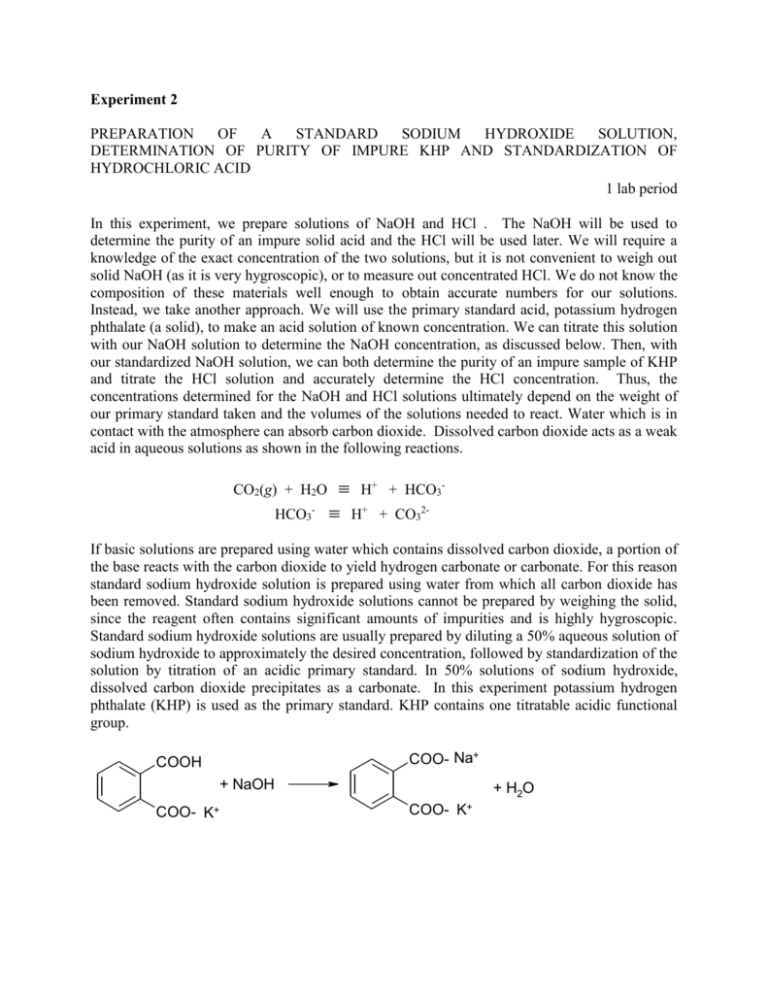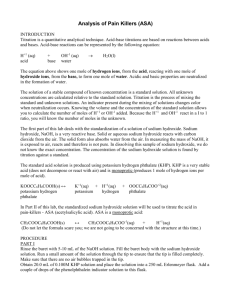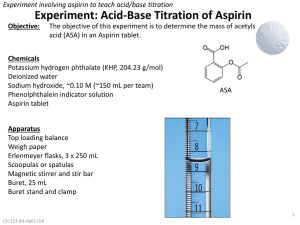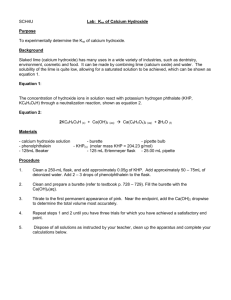Experiment 2
advertisement

Experiment 2 PREPARATION OF A STANDARD SODIUM HYDROXIDE SOLUTION, DETERMINATION OF PURITY OF IMPURE KHP AND STANDARDIZATION OF HYDROCHLORIC ACID 1 lab period In this experiment, we prepare solutions of NaOH and HCl . The NaOH will be used to determine the purity of an impure solid acid and the HCl will be used later. We will require a knowledge of the exact concentration of the two solutions, but it is not convenient to weigh out solid NaOH (as it is very hygroscopic), or to measure out concentrated HCl. We do not know the composition of these materials well enough to obtain accurate numbers for our solutions. Instead, we take another approach. We will use the primary standard acid, potassium hydrogen phthalate (a solid), to make an acid solution of known concentration. We can titrate this solution with our NaOH solution to determine the NaOH concentration, as discussed below. Then, with our standardized NaOH solution, we can both determine the purity of an impure sample of KHP and titrate the HCl solution and accurately determine the HCl concentration. Thus, the concentrations determined for the NaOH and HCl solutions ultimately depend on the weight of our primary standard taken and the volumes of the solutions needed to react. Water which is in contact with the atmosphere can absorb carbon dioxide. Dissolved carbon dioxide acts as a weak acid in aqueous solutions as shown in the following reactions. CO2(g) + H2O HCO3- H+ + HCO3 H+ + CO32- If basic solutions are prepared using water which contains dissolved carbon dioxide, a portion of the base reacts with the carbon dioxide to yield hydrogen carbonate or carbonate. For this reason standard sodium hydroxide solution is prepared using water from which all carbon dioxide has been removed. Standard sodium hydroxide solutions cannot be prepared by weighing the solid, since the reagent often contains significant amounts of impurities and is highly hygroscopic. Standard sodium hydroxide solutions are usually prepared by diluting a 50% aqueous solution of sodium hydroxide to approximately the desired concentration, followed by standardization of the solution by titration of an acidic primary standard. In 50% solutions of sodium hydroxide, dissolved carbon dioxide precipitates as a carbonate. In this experiment potassium hydrogen phthalate (KHP) is used as the primary standard. KHP contains one titratable acidic functional group. COO- Na+ COOH + NaOH COO- K+ + H2O COO- K+ Prelaboratory Assignment A 0.5123-g KHP (M.W. 204.23) sample was dissolved in about 25 mL of distilled water, and titrated to the phenolphthalein end point with 28.75 mL of a sodium hydroxide solution. Calculate the molar concentration of the hydroxide solution. Apparatus 3 250-mL Erlenmeyer flasks 50-mL buret 10-mL graduated cylinder 100-mL graduated cylinder 1000-mL boiling flask 25-mL pipet two 1-L polyethylene bottles or glass bottles with screw caps weighing bottle for drying KHP Chemicals hydrochloric acid (6 M) phenolphthalein solution (0.l% in ethanol) potassium hydrogen phthalate (analytical grade) impure potassium hydrogen phthalate 6 M sodium hydroxide solution Procedure Stock Solution of HCl Obtain about 8 mL of concentrated hydrochloric acid and dilute to about 1 L with deionized water. Mix well, then place in a 1-L glass bottle or in a 1-L polyethylene bottle for storage. The hydrochloric acid now has a concentration near 0.1 M. Clearly label and set this solution aside for future use. A. Standardization of NaOH 1. Dry about 3 g each of pure and impure potassium hydrogen phthalate in a l00C oven for at least one hour. Use your weighing bottle, without lid, to hold the solid. Label a 150-mL beaker, put the weighing bottle in the beaker and cover with a watch glass. Always use this method to dry solids. 2. Add about 17 mL (use a 50-mL graduated cylinder) of 6.0 M sodium hydroxide solution to the 1-liter bottle. Fill the bottle to its shoulder with distilled water. Place the stopper or the lid on the bottle, and thoroughly mix the solution by shaking the bottle. 3. After having dried in the oven for at least one hour, place the KHP in a desiccator to cool to room temperature. This usually requires about 15 minutes. Weighing a warm solid will introduce substantial errors, so be sure the solid is cool. 4. Weigh three 0.4 to 0.7-g samples of the pure KHP to the nearest 0.1 mg. Place each sample in a labeled, 250-mL Erlenmeyer flask. Add about 30 mL of distilled or deionized water to each flask, and dissolve the KHP. 5. Add two or three drops of phenolphthalein solution to each flask, fill the 50-mL buret with sodium hydroxide solution, and titrate the KHP solution in each flask to the end point. At the end point the solution changes from colorless to a faint pink. B. Determination of Purity of KHP 6. Repeat steps 1 through 5 for the impure KHP samples, this time weighing out between 0.7 and 1.0 g for each measurement. 7. Discard the titrated solutions in each of the three Erlenmeyer flasks, and rinse the flasks first with tap water, and then with distilled or deionized water. C. Standardization of HCl 8. Pipet 25 mL of the hydrochloric acid sample into each of the three flasks, and dilute with about 25 mL (use a graduated cylinder) of the boiled water. 9. Add two or three drops of phenolphthalein to each flask, and titrate each solution to the end point with the sodium hydroxide solution. 10. Because the standardized sodium hydroxide solution will be used in future experiments, place the rubber stopper or lid on the bottle, and store the solution. Also store the hydrochloric acid. You depend on the stability of these solutions, so be careful! Calculations 1. Use the mass of pure KHP added to each flask, and the volume of sodium hydroxide solution used in each of the three standardization titrations to calculate the concentration of sodium hydroxide used in each titration. 2. Calculate the average sodium hydroxide concentration and the standard deviation of the results. 3. Use the mass of impure KHP added to each flask and the volume of the NaOH solution to calculate the purity of the impure sample of KHP. Again, calculate the standard deviation of the results. 4. Use the average sodium hydroxide concentration, the end point volume for each titration, and the volume of the hydrochloric acid sample used in each titration to calculate the concentration of the hydrochloric acid sample. 5. Calculate the average hydrochloric acid concentration and the standard deviation of the results. 6. Check your calculations for errors. Is your answer reasonable? 7. Report on the form provided the values as well as the average concentrations found for the sodium hydroxide and hydrochloric acid solutions. Include the standard deviations and the relative standard deviations for both standardizations. Further Readings 1. D. C. Harris, Quantitative Chemical Analysis, 5th ed., Freeman and Sons, San Francisco, 1995, Chapter 12. 2. G. D. Christian, Analytical Chemistry, 5th Edition, John Wiley & Sons, New York, Chapter 7. Experiment 2 Name ________________________ Standardization of NaOH and HCl Solutions and Determination of Purity of KHP Purpose Data and Calculations Part A Replication Wt. of pure KHP, g Vol. of NaOH, mL Conc. of NaOH, M 1 2 3 2 3 2 3 Mean conc. NaOH solution: ________M Standard deviation: _______ M Relative standard deviation (RSD): ______% (Note: RSD = [Standard Deviation/Mean] x 100% Part B Replication Wt. of impure KHP, Vol. of NaOH, mL 1 Purity of KHP, % Mean purity of KHP: ________% Standard deviation: _______ % Relative standard deviation (RSD): ______% Part C Replication Volume of HCl, mL Vol. of NaOH, mL Conc. of HCl, M 1 Mean conc. HCl solution: ________M Standard deviation: _______ M Relative standard deviation (RSD): ______% Include sample calculations for all three experiments below: Questions 1. What is the difference between a primary and a secondary standard? Give an example of each. 2. What is the purpose of boiling the water used to make the NaOH solution? Why didn’t you boil the water for the HCl solution? 3. Why is it better to use a 50% NaOH solution, instead of solid NaOH, to prepare the 0.1 M NaOH solution? 4. If you had to weigh out solid NaOH on an analytical balance, how would you do it?








